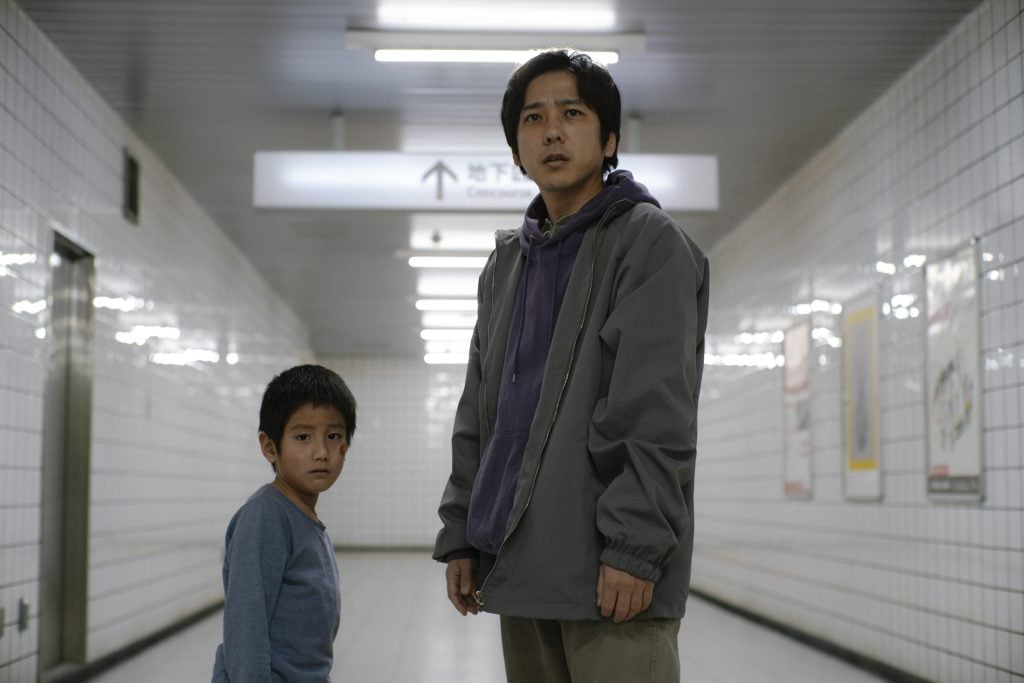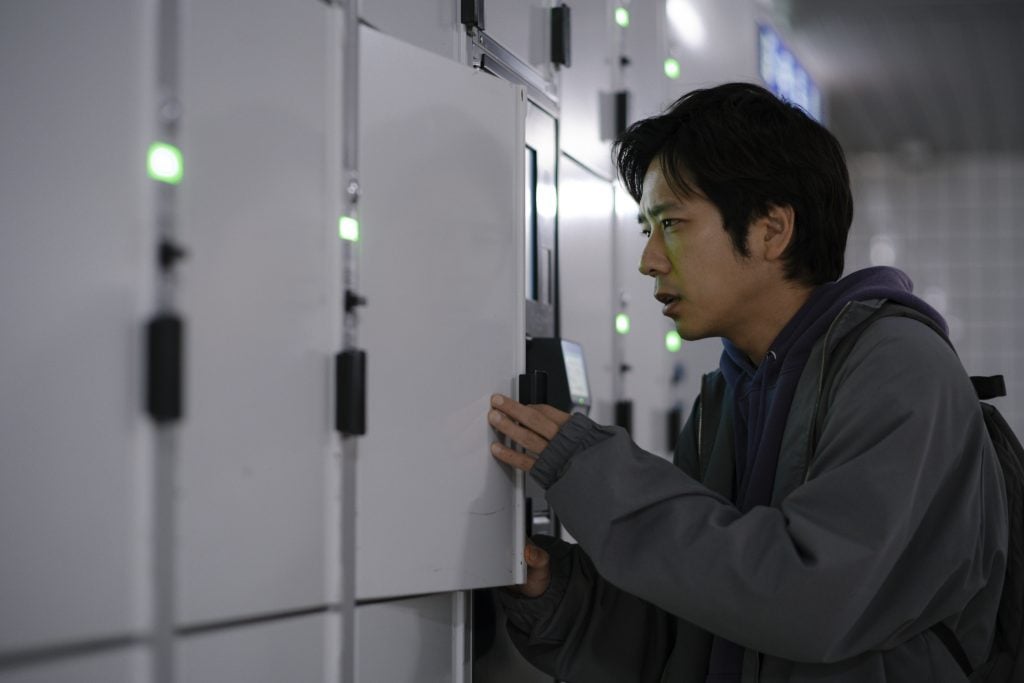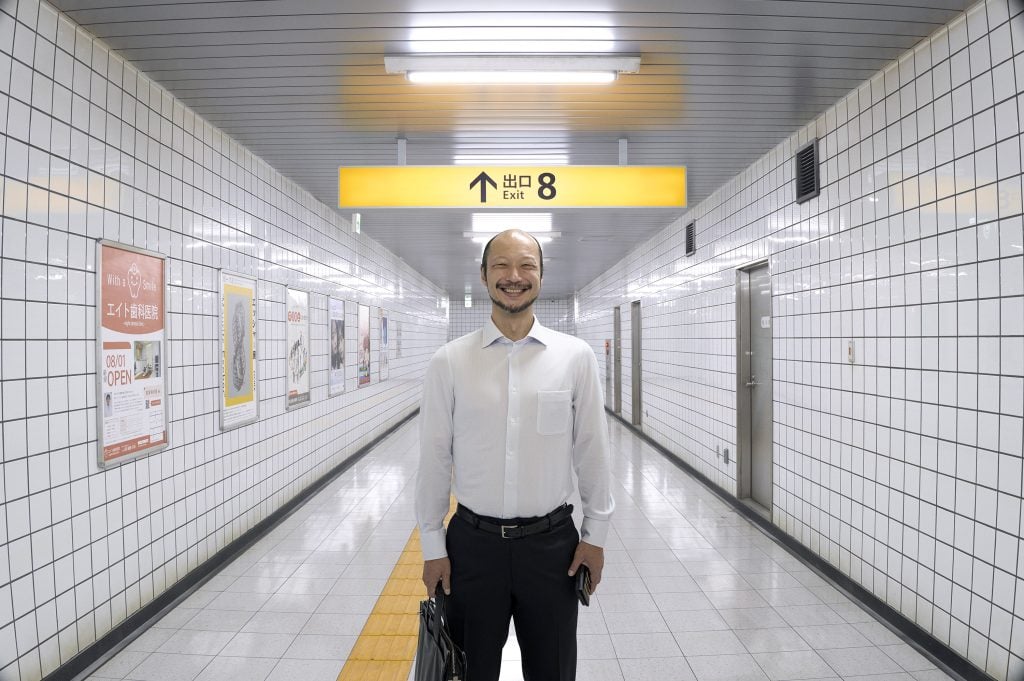Commuting sucks.
No matter how far you are from your place of work, traveling with scores of people participating in the same forced ritual can often feel like you’re stuck on a hamster wheel. The difference is, you’re being jostled between people crammed onto a subway, or stuck in inch-by-inch traffic in a car or on a bus, or you’re listening to someone ramble about any given topic that is determined to drain your energy before you even have your first cup of coffee.
Exit 8, the film by Genki Kawamura that held its North American premiere at the 2025 Toronto International Film Festival, takes the abstract horrors of the blue-and-white-collar city commutes and makes them tangible. Based on the video game by Kotake Create, the film follows the Lost Man (Kazunari “Nino” Ninomiya) as he navigates a hellish permutation of his commute. He is effectively stuck in a subway station hallway. To leave the hallway through the titular exit, he must follow the rules written on the wall: if he sees any anomalies, he must turn back. If he doesn’t, he’ll repeat the same path, a Groundhog Day of morning travels. He isn’t the only one stuck, though, and we soon get a full scope of how one’s choices, or lack thereof, have concrete (pun intended) consequences on their humanity.

If you’re unfamiliar with The Exit 8 game (as I was), Kawamura does a great job recreating the psychological conditions to draw you into the same work that the Lost Man and others must do. As they repeat the same path over and over, you find yourself right alongside them, counting the posters on the wall, the doors and their respective knobs, and even whether or not the lights flicker, trying to find the correct anomaly. Kawamura keeps his camera dynamic, shifting perspectives to clue us in to changes in the map, encouraging us to shout, groan, or cheer at the screen when a commuter catches or misses an anomaly. It makes for a wholly immersive experience that, despite the built-in repetition, doesn’t wear out its welcome. It helps that the atmosphere that Kawamura creates, with his close-ups and his deployment of Yasutaka Nakata and Shohei Amimori’s foreboding score, is so suffocating that whatever distractions may exist simply don’t register.
However, gameplay does not make for a good film, which means that Kawamura also has to construct a compelling narrative around the mechanics. He also succeeds on this front, using the game itself to stage a commentary on passivity. Before the Lost Man enters the proper hallway, he confronts two challenging moments: a man yelling at a woman with a crying baby on the subway, and a phone call with his girlfriend about her recently discovered pregnancy. Both situations present the Lost Man with opportunities to either step up or step aside, with him ultimately choosing the latter. The film doesn’t outright say his indecision is responsible for his participation in the game, but it certainly feels like it, the hallway punishing him for his lack of focus and indecision.

The punishment manifests in two ways, with two results of varying effectiveness. Exit 8 is strongest when it keeps its consequences off-screen, keeping its players off-kilter by the promise of something awful. The crying babies trapped inside the lockers or the rats scurrying inside the walls are plenty terrifying alongside the game’s repetitive cycles. The Walking Man (Yamato Kochi), another person trapped in the hallway, believes he’s found salvation once he reaches a staircase, but the rules tell us it’s an anomaly. We don’t know his fate, but we don’t need to; our imagination can fill in the horrors for us. The psychological trickery is much more effective than Kawamura’s showing us deformed rats or flooding the hallway with sewage. Sure, they are scary and will make you jump in surprise, but they don’t reverberate as powerfully as the unseen scares do.
What also reverberates is Kazunari “Nino” Ninomiya’s work. Exit 8 rests on his shoulders, with anything less than a fully committed performance that makes us believe he’s trapped in a purgatorial prison of his own making. He hits the mark head-on, not just in conveying the Lost Man’s rapidly spreading fear, but also in demonstrating the laser-sharp focus required to break free and the frustration of failing to do so over and over again. It’s a neat trick, making us irritated at him for missing something as obvious as a doorknob in the middle of the door, but also feel bad because he’s at least trying to improve. It’s a great performance that grounds this high-concept, heady thriller.

It’s nice to have a film validate your belief that commutes are inherently terrible and exist to drive you insane. More than that, though, Exit 8 is a genuinely stressful and exhilarating horror experience. Kawamura stresses that we should be more proactive, even during something as deadening as a morning subway ride. At a time when we sink deeper into our phones during these commutes, slipping further away from our collective sense of humanity, this film is a fun, thrilling call to wake us up.
Exit 8 held its North American Premiere as part of the Centrepiece section at the 2025 Toronto International Film Festival.
Director: Genki Kawamura
Screenwriters: Kentaro Hirase, Genki Kawamura
Rated: NR
Runtime: 95m
Exit 8 is a genuinely stressful and exhilarating horror experience. Kawamura stresses that we should be more proactive, even during something as deadening as a morning subway ride. At a time when we sink deeper into our phones during these commutes, slipping further away from our collective sense of humanity, this film is a fun, thrilling call to wake us up.
-
GVN Rating 8
-
User Ratings (0 Votes)
0
A late-stage millennial lover of most things related to pop culture. Becomes irrationally irritated by Oscar predictions that don’t come true.




![‘Jay Kelly’ Review – Noah Baumbach Makes A Case For The Magic Of Movie Stardom [NYFF 2025] ‘Jay Kelly’ Review – Noah Baumbach Makes A Case For The Magic Of Movie Stardom [NYFF 2025]](https://cdn.geekvibesnation.com/wp-media-folder-geek-vibes-nation/wp-content/uploads/2025/11/Jay-Kelly-JKELLY_20240523_15320_C2_R-300x180.jpg)

